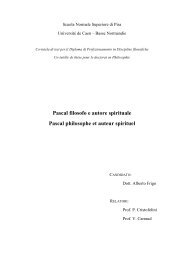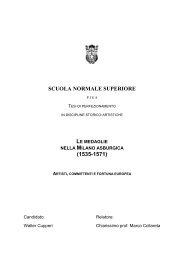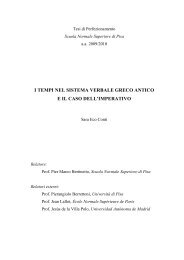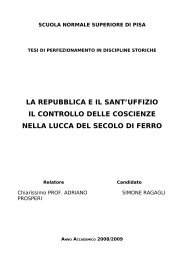CATULLUS 68 - Scuola Normale Superiore
CATULLUS 68 - Scuola Normale Superiore
CATULLUS 68 - Scuola Normale Superiore
You also want an ePaper? Increase the reach of your titles
YUMPU automatically turns print PDFs into web optimized ePapers that Google loves.
interpretation. The same phenomenon can be observed in the recentiores, where the three forms of names<br />
beginning with an M (mali at lines 11 and 30 and manlius at line 66 in G and R, from which most or all<br />
recentiores descend) and the adjective maulia at line 54 are given similar forms quite often: fifteen MSS (my<br />
MSS 4 7 10 28 31 52 66 and class η) write forms of Manlius (manli, manlia and manlius) in all four<br />
passages, while two (12 and 45) write forms of the fictitious name *Mamlius (mamli, mamlia and mamlius).<br />
The same phenomenon appears to have given rise to the principal MSS’ manlia in line 54. This means that a<br />
relatively early MS, probably an ancestor of the pre-archetype V, contained forms of the name Manlius.<br />
Since this is as far as we can go back in the manuscript tradition, on the basis of its authority alone we would<br />
have to reconstruct forms of the name Manlius.<br />
The names Manlius and Mallius are often confused in the MSS of classical authors with each other (and also<br />
with the name Manilius, which can fortunately be excluded here for metrical reasons). 71 On one hand, the<br />
name Manlius, of foreign (possibly Etruscan) origin, contains the consonant cluster –nl–, which Latin<br />
generally assimilates to –ll– (conloquium > colloquium): Manlius may not have been pronounced very<br />
differently from Mallius. On the other hand, the phonologically more straightforward name Mallius is much<br />
more rare than Manlius: RE lists 101 Manlii and 7 Manliae against only 17 Mallii. The confusion of these<br />
gentilicia is so widespread that there are many more cases in which it is hardly possible to tell which name a<br />
person bore. 72 As a result, we cannot escape the problem of infinite regress: if we succeed to prove that an<br />
early MS contained a form of either of the names Manlius and Mallius, it always remains possible that it<br />
should have arisen from a form of the other name. It might never be possible to reach certainty in this matter.<br />
However, the odds are in favour of Manlius: this has better manuscript authority than Mallius and it is about<br />
six times more common, as we have seen.<br />
It may or may not be relevant that in another poem of Catullus’, in the wedding-song that is our poem 61,<br />
there appears a person who was certainly called Manlius. There the principal manuscripts treat the<br />
bridegroom with true impartiality and make him once a Mallius (61.16 mallio OGR) and once a Manlius<br />
(61.215 maulio O: manlio GR). However, a son that he might have in the future is referred to as torquatus<br />
(thus GR at 61.209: O has torcutus), so that he can be identified as a member of the venerable and numerous<br />
patrician family of the Manlii Torquati (a full 21 of the 101 Manlii listed in RE are assigned to their ranks).<br />
They appear to have insisted firmly on spelling their name as Manlius rather than Mallius. 73 Can our Manlius<br />
(if that was indeed his name) be identified with the Manlius Torquatus celebrated in poem 61? This was first<br />
suggested by Muretus in 1554 and has been proposed repeatedly since then. 74 However, it is the question<br />
71<br />
Thus RE 14.1.909f. and 1149.<br />
72<br />
RE 14.1.1149.<br />
73<br />
RE 14.1.1149.<br />
74<br />
Thus already Rode 1785: 81 (“Manlius, an den dieser Brief gerichtet, ist wahrscheinlich derselbe Manlius Torquatus,<br />
der den Katull nach Rom gebracht, und auf dessen Vermählung mit einer Julia wir ein schönes Hochzeitsgedicht unter<br />
38






